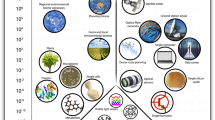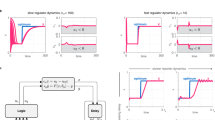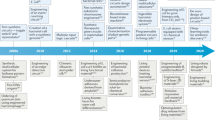Abstract
Small-scale production of biologics has great potential for enhancing the accessibility of biomanufacturing. By exploiting cell–material feedback, we have designed a concise platform to achieve versatile production, analysis and purification of diverse proteins and protein complexes. The core of our technology is a microbial swarmbot, which consists of a stimulus-sensitive polymeric microcapsule encapsulating engineered bacteria. By sensing the confinement, the bacteria undergo programmed partial lysis at a high local density. Conversely, the encapsulating material shrinks responding to the changing chemical environment caused by cell growth, squeezing out the protein products released by bacterial lysis. This platform is then integrated with downstream modules to enable quantification of enzymatic kinetics, purification of diverse proteins, quantitative control of protein interactions and assembly of functional protein complexes and multienzyme metabolic pathways. Our work demonstrates the use of the cell–material feedback to engineer a modular and flexible platform with sophisticated yet well-defined programmed functions.
This is a preview of subscription content, access via your institution
Access options
Access Nature and 54 other Nature Portfolio journals
Get Nature+, our best-value online-access subscription
$29.99 / 30 days
cancel any time
Subscribe to this journal
Receive 12 print issues and online access
$259.00 per year
only $21.58 per issue
Buy this article
- Purchase on Springer Link
- Instant access to full article PDF
Prices may be subject to local taxes which are calculated during checkout





Similar content being viewed by others
Data availability
All data generated or analyzed during the current study are available from the corresponding author on reasonable request.
Code availability
All code used in this study is available from the author upon reasonable request.
References
Baeshen, M. N. et al. Production of biopharmaceuticals in E. coli: current scenario and future perspectives. J. Microbiol. Biotechnol. 25, 953–962 (2015).
Walsh, G. Biopharmaceutical benchmarks 2014. Nat. Biotechnol. 32, 992–1000 (2014).
Gottschalk, U., Brorson, K. & Shukla, A. A. The need for innovation in biomanufacturing. Nat. Biotechnol. 30, 489–492 (2012).
Dove, A. Uncorking the biomanufacturing bottleneck. Nat. Biotechnol. 20, 777–779 (2002).
Patient-centered drug manufacture. Nat. Biotechnol. 35, 485 (2017).
Schellekens, H., Aldosari, M., Talsma, H. & Mastrobattista, E. Making individualized drugs a reality. Nat. Biotechnol. 35, 507–513 (2017).
Choi, E. J. & Ling, G. S. Battlefield medicine: paradigm shift for pharmaceuticals manufacturing. PDA J. Pharm. Sci. Technol. 68, 312 (2014).
Ashok, A., Brison, M. & LeTallec, Y. Improving cold chain systems: challenges and solutions. Vaccine 35, 2217–2223 (2017).
Shukla, A. & Gottschalk, U. Single-use disposable technologies for biopharmaceutical manufacturing. Trends Biotechnol. 31, 147–154 (2013).
Lopes, A. Single-use in the biopharmaceutical industry: a review of current technology impact, challenges and limitations. Food Bioprod. Process. 93, 98–114 (2015).
Schilling, E., Kamholz, A. & Yager, P. Cell lysis and protein extraction in a microfluidic device with detection by a fluorogenic enzyme assay. Anal. Chem. 74, 1798–1804 (2002).
Jacquemart, R. et al. A single-use strategy to enable manufacturing of affordable biologics. Comput. Struct. Biotechnol. J. 14, 309–318 (2016).
Allison, N. & Richards, J. Current status and future trends for disposable technology in the biopharmaceutical industry. J. Chem. Technol. Biotechnol. 89, 1283–1287 (2014).
Mergulhão, F. J., Summers, D. K. & Monteiro, G. A. Recombinant protein secretion in Escherichia coli. Biotechnol. Adv. 23, 177–202 (2005).
Green, E. R. & Mecsas, J. Bacterial secretion systems: an overview. Microbiol. Spectr. https://doi.org/10.1128/microbiolspec.VMBF-0012-2015 (2016).
Mergulhao, F. J. M. & Monteiro, G. A. Secretion capacity limitations of the Sec pathway in Escherichia coli. J. Microbiol. Biotechnol. 14, 128–133 (2004).
Xiyu, J., Jan, K. & Anthony, C. J. Controlled lysis of bacteria. US patent 7892811B2 (2011).
Din, M. O. et al. Synchronized cycles of bacterial lysis for in vivo delivery. Nature 536, 81–85 (2016).
Pardee, K. et al. Portable, on-demand biomolecular manufacturing. Cell 167, 248–259 (2016).
Karig, D. K., Bessling, S., Thielen, P., Zhang, S. & Wolfe, J. Preservation of protein expression systems at elevated temperatures for portable therapeutic production. J. R. Soc. Interface 14, 20161039 (2017).
Underwood, K. A., Swartz, J. R. & Puglisi, J. D. Quantitative polysome analysis identifies limitations in bacterial cell-free protein synthesis. Biotechnol. Bioeng. 91, 425–435 (2005).
Stech, M., Quast, R. B., Sachse, R., Schulze, C. & Kubick, D. A. W. S. A continuous-exchange cell-free protein synthesis system based on extracts from cultured insect cells. PLoS One 9, e96635 (2014).
Gutowska, A. et al. Squeezing hydrogels for controlled oral drug delivery. J. Control. Release 48, 141–148 (1997).
Eichenbaum, G. M., Kiser, P. F., Dobrynin, A. V., Simon, S. A. & Needham, D. Investigation of the swelling response and loading of ionic microgels with drugs and proteins: the dependence on cross-link density. Macromolecules 32, 4867–4878 (1999).
Huang, X. & Brazel, C. S. On the importance and mechanisms of burst release in matrix-controlled drug delivery systems. J. Control. Release 73, 121–136 (2001).
Marguet, P., Tanouchi, Y., Spitz, E., Smith, C. & You, L. Oscillations by minimal bacterial suicide circuits reveal hidden facets of host–circuit physiology. PLoS One 5, e11909 (2010).
Lopez-Leon, T., Carvalho, E., Seijo, B., Ortega-Vinuesa, J. & Bastos-Gonzalez, D. Physicochemical characterization of chitosan nanoparticles: electrokinetic and stability behavior. J. Colloid Interface Sci. 283, 344–351 (2005).
Gu, Z. et al. Glucose-responsive microgels integrated with enzyme nanocapsules for closed-loop insulin delivery. ACS Nano 7, 6758–6766 (2013).
Jonassen, H., Kjoniksen, A. L. & Hiorth, M. Effects of ionic strength on the size and compactness of chitosan nanoparticles. Colloid Polym. Sci. 290, 919–929 (2012).
Balagaddé, F. K., You, L., Hansen, C. L., Arnold, F. H. & Quake, S. R. Long-term monitoring of bacteria undergoing programmed population control in a microchemostat. Science 309, 137–140 (2005).
Tanouchi, Y., Pai, A., Buchler, N. E. & You, L. Programming stress-induced altruistic death in engineered bacteria. Mol. Syst. Biol. 8, 626 (2012).
Sun, F., Zhang, W. B., Mahdavi, A., Arnold, F. H. & Tirrell, D. A. Synthesis of bioactive protein hydrogels by genetically encoded SpyTag–SpyCatcher chemistry. Proc. Natl Acad. Sci. USA 111, 11269–11274 (2014).
Meyer, D. E. & Chilkoti, A. Purification of recombinant proteins by fusion with thermally-responsive polypeptides. Nat. Biotechnol. 17, 1112–1115 (1999).
Kwon, K. et al. High quality protein microarray using in situ protein purification. BMC Biotechnol. 9, 72 (2009).
Ge, X., Trabbic-Carlson, K., Chilkoti, A. & Filipe, C. D. Purification of an elastin-like fusion protein by microfiltration. Biotechnol. Bioeng. 95, 424–432 (2006).
Amiram, M., Luginbuhl, K. M., Li, X., Feinglos, M. N. & Chilkoti, A. Injectable protease-operated depots of glucagon-like peptide-1 provide extended and tunable glucose control. Proc. Natl Acad. Sci. USA 110, 2792–2797 (2013).
Lusvarghi, S. & Bewley, C. A. Griffithsin: an antiviral lectin with outstanding therapeutic potential. Viruses 8, 296 (2016).
Amato, G. et al. Recombinant growth hormone (GH) therapy in GH-deficient adults: a long-term controlled study on daily versus thrice weekly injections. J. Clin. Endocrinol. Metab. 85, 3720–3725 (2000).
Ihssen, J. et al. Production of glycoprotein vaccines in Escherichia coli. Microb. Cell Fact 9, 61 (2010).
Tsoi, R. et al. Metabolic division of labor in microbial systems. Proc. Natl Acad. Sci. USA 115, 2526–2531 (2018).
Villarreal, F. et al. Synthetic microbial consortia enable rapid assembly of pure translation machinery. Nat. Chem. Biol. 14, 29–35 (2018).
Scott, S. R. et al. A stabilized microbial ecosystem of self-limiting bacteria using synthetic quorum-regulated lysis. Nat. Microbiol. 2, 17083 (2017).
Xu, P. et al. Modular optimization of multi-gene pathways for fatty acids production in E. coli. Nat. Commun. 4, 1409 (2013).
Yu, X., Liu, T., Zhu, F. & Khosla, C. In vitro reconstitution and steady-state analysis of the fatty acid synthase from Escherichia coli. Proc. Natl Acad. Sci. USA 108, 18643–18648 (2011).
Heath, R. J. & Rock, C. O. Enoyl-acyl carrier protein reductase (fabI) plays a determinant role in completing cycles of fatty acid elongation in Escherichia coli. J. Biol. Chem. 270, 26538–26542 (1995).
Bi, H. K., Christensen, Q. H., Feng, Y. J., Wang, H. H. & Cronan, J. E. The Burkholderia cenocepacia BDSF quorum sensing fatty acid is synthesized by a bifunctional crotonase homologue having both dehydratase and thioesterase activities. Mol. Microbiol. 83, 840–855 (2012).
Pardee, K. et al. Paper-based synthetic gene networks. Cell 159, 940–954 (2014).
Lopatkin, A. J. & You, L. Synthetic biology looks good on paper. Cell 159, 718–720 (2014).
Perez-Pinera, P. et al. Synthetic biology and microbioreactor platforms for programmable production of biologics at the point-of-care. Nat. Commun. 7, 12211 (2016).
Hoare, T. R. & Kohane, D. S. Hydrogels in drug delivery: progress and challenges. Polymer 49, 1993–2007 (2008).
Worthington, A. S., Rivera, H., Torpey, J. W., Alexander, M. D. & Burkart, M. D. Mechanism-based protein cross-linking probes to investigate carrier protein-mediated biosynthesis. ACS Chem. Biol. 1, 687–691 (2006).
Lopatkin, A. J. et al. Antibiotics as a selective driver for conjugation dynamics. Nat. Microbiol. 1, 16044 (2016).
Huang, S. et al. Coupling spatial segregation with synthetic circuits to control bacterial survival. Mol. Syst. Biol. 12, 859 (2016).
Yu, T. et al. Reprogramming yeast metabolism from alcoholic fermentation to lipogenesis. Cell 174, 1549–1558 (2018).
Acknowledgements
We thank M. Lynch for plasmid constructs, insightful comments and suggestions; D.A. Tirrell, Y. Zhang and F. Sun for plasmid constructs; K. Zhu and K. Luginbuhl for insightful suggestions; J. Decker for useful suggestions; and P. Li, B. Chen, Q. Hu, X. Peng and Y. Zhang for assistance in revision. This study was partially supported by the U.S. Army Research Office under grant W911NF-14-1-0490 (to L.Y.), the National Institutes of Health (grant R01-GM098642 to L.Y. and grant R35GM127042 to A.C.), the Office of Naval Research (grant N00014-12-1-0631 to L.Y.), Beijing Municipal Natural Science Foundation (grant 5182017 to Z.L.) and a David and Lucile Packard Fellowship to L.Y.
Author information
Authors and Affiliations
Contributions
Z.D. conceived the research, designed and performed experiments, interpreted the results, assisted in the model development and wrote the manuscript. A.J.L. developed the model and assisted in experimental setup, data interpretation and manuscript revisions. S.R. assisted in performing experiments, data analysis and manuscript revisions. T.A.S. and S.H. assisted in experimental setup, data interpretation and manuscript revisions. M.D. and X.Y. assisted in performing experiments, data interpretation and manuscript revisions. X.Z. and Z.L. assisted in performing experiments during the manuscript revisions. A.C. assisted in research design, experimental setup, data interpretation and manuscript revisions. L.Y. conceived the research and assisted in research design, modeling, data interpretation and manuscript writing.
Corresponding author
Ethics declarations
Competing interests
The authors declare no competing interests.
Additional information
Publisher’s note: Springer Nature remains neutral with regard to jurisdictional claims in published maps and institutional affiliations.
Supplementary information
Supplementary information
Supplementary Tables 1–3 and Supplementary Figures 1–18
Supplementary Video 1
Oscillatory behavior of engineered cells was observed on the microfluidic device.
Supplementary Video 2
Capsules carrying engineered bacteria shrunk with cell growth.
Supplementary Video 3
Capsules carrying engineered bacteria swelled slightly before shrinking with cell growth.
Supplementary Video 4
Oscillations of the capsule size in the culture chamber were observed under microscopy.
Supplementary Video 5
Periodic accumulation of fluorescence in the assay chamber were observed under microscopy.
Supplementary Video 6
Response of chitosan capsules to periodic change in pH.
Supplementary Video 7
Alginate capsules maintain the same size at varied chemical conditions.
Rights and permissions
About this article
Cite this article
Dai, Z., Lee, A.J., Roberts, S. et al. Versatile biomanufacturing through stimulus-responsive cell–material feedback. Nat Chem Biol 15, 1017–1024 (2019). https://doi.org/10.1038/s41589-019-0357-8
Received:
Accepted:
Published:
Issue Date:
DOI: https://doi.org/10.1038/s41589-019-0357-8
This article is cited by
-
Accelerating the design of pili-enabled living materials using an integrative technological workflow
Nature Chemical Biology (2024)
-
A de novo matrix for macroscopic living materials from bacteria
Nature Communications (2022)
-
Modulation of microbial community dynamics by spatial partitioning
Nature Chemical Biology (2022)
-
Engineering consortia by polymeric microbial swarmbots
Nature Communications (2022)
-
Engineered microbial consortia: strategies and applications
Microbial Cell Factories (2021)



